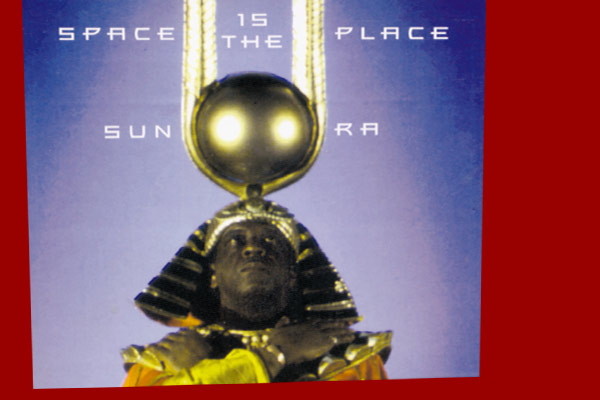

Sun Ra is roaming the space on a rocket that is fueled with music (!), looking for a place on the restless planet Earth where a black-skinned man could safely land and have a rest. Following a seemingly endless search he decides, in a time close to year 1972, to land in Oakland. Hostilities between Ra, FBI, NASA and an abominable, supernatural pimp called The Overseer ensue, and Ra’s “Black Space Program” finally faces a dead end on Earth, forcing it to return to space as the only possible solution.
Space Is The Place is a cult film directed in 1974 by John Coney and starring the legend of free jazz, Sun Ra (1914-1993). The film was long assumed to be lost entirely, but is now available again in a magnificently restored version. It is an astonishing portrayal of the atmosphere and mentality of the early 1970s United States of America and the values of its post-Vietnam society. In the story, Coney and his co-writer Ra combine the racial politics of the Black Panthers with the post-war anxiety of Vietnam veterans, the cosmic big band compositions of the Sun Ra Arkestra and the aesthetics of 1950s science fiction. The film is based on Sun Ra's Afro-Egyptian imaginary mythology, and has been aptly described as “part documentary, part science fiction, part blaxploitation, part revisionist biblical epic.” It is said that during the shooting of the film Ra sought inspiration by ceaselessly reading The Urantium Book, a 2000-page epic where the whole destructive history of the universe so far is set on a right course by the appearance on Earth of a divine musician.
THURSTON MOORE
Sun Ra came from Saturn. And where he’s gone is neither here nor there. Most beings with the creative genius mind, roaming the Earth’s streets, are of inter-planetary origin. The unenlightened see them as freaks, exotics and eccentrics. Alexander Scriabin, Eliane Radigue, Moondog, Albert Ayler, Maryanne Amacher, Captain Beefheart - artists critically referred to as otherworldly and mystic. These beings situate themselves here as sentient, sensuous artists with music, a very primary force to communicate with their sacred mothership. The mothership is the vehicle, the conduit betwixt knowledge and liberation and those societies in need. So it is with holistic regard that those with longstanding Earth roots study the works of these artists so as to glean information from the knowledge-spheres. These origins are from whence energy/ life- force and intellect becomes free and immortal: born of the cosmos.
Fortune finds you the cosmic messenger in articulation to this planet’s spoken word in tune with his/her more abstract teachings of cosmic philosophy. Sun Ra appeals to the sensibility of the irreal. He believed man a victim of mixed signals (one LP’s title is It Is After The End Of The World) and that truth was to be found in the lower strata of daily life. He surrounded himself with musicians chosen for their antisocial and downtrodden nature and created a cult of mystic dialogue, sophisticated artistry and disciplined ritual.
Sun Ra had a keen and scholarly interest in linguistics. His library of Egyptology, world theology, and race theory is dizzying and profound. Throughout the 50s and 60s Sun Ra integrated and developed a musical theatre of concepts derived from “antique” black teachings. It referenced cosmology and philosophy through the traditional American swing music of Fletcher Henderson. Sun Ra and his Arkestra’s radical fire music performances in NYC during the late 60s/early 70s were undoubtedly some of the most beautiful and heavy moments of a truly transcendent avant-garde. Amiri Baraka claimed Ra to be an intellectual visionary of Black Art. John Coltrane moved into dimensions of playing admittedly influenced by Sun Ra. Ra was an authentic outsider always speaking in gentle, cryptic terms. He and his coterie walked the streets living hand-to-mouth and wearing space robes and glitter. They were completely and utterly hip.
The true nature of Sun Ra’s call is seemingly man’s right to liberation through space travel and cosmic tones. Though his expression remains far-out he was certainly not alone. Sun Ra biographer John Szwed proves this by prefacing his story with this beautiful quote from Louis Armstrong: “Our music is a Secret Order”. You either believe or you don’t. Charles Mingus believed whole heartedly in Sun Ra as when Ra first came to New York and walked into the Five Spot. “What are you doing down here, Sunny?” Sun answered, “I come down to the Village a lot.” “No,” said Mingus, “I mean what are you doing down here on Earth!”
Space Is The Place
USA 1974. 82 minutes.
Directed by John Coney.
Produced by Jim Newman.
Distribution by Plexifilm.
Written by Joshua Smith.
Music by Sun Ra and The Intergalactic
Myth-Science Solar Arkestra.
Starring Sun Ra (Sun Ra), Ray Johnson
(The Overseer), Christopher Brooks
(Jimmy Frey), Barbara Deloney (Candy),
Erika Leder (Tania), John Bailey (Bubbles),
Clarence Brewer (Bernard), Ron
Vernon (Agent #1), Morgan Upton (Agent
#2), Sinthia Ayala (Chili Pepper) and La
Shaa Stallings (Bertha).
John Coney's Space Is The Place will be screened in the Kiasma Theatre on Friday, November 19th at 15.00.
Last minute addition: Phill Niblock's The Magic Sun (1968), a short film about Sun Ra, will be screened at Avanto Nightclub in Mocambo on Thursday, November 18th.